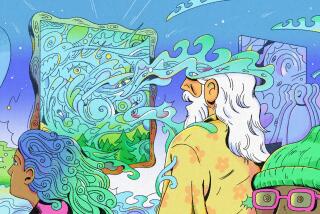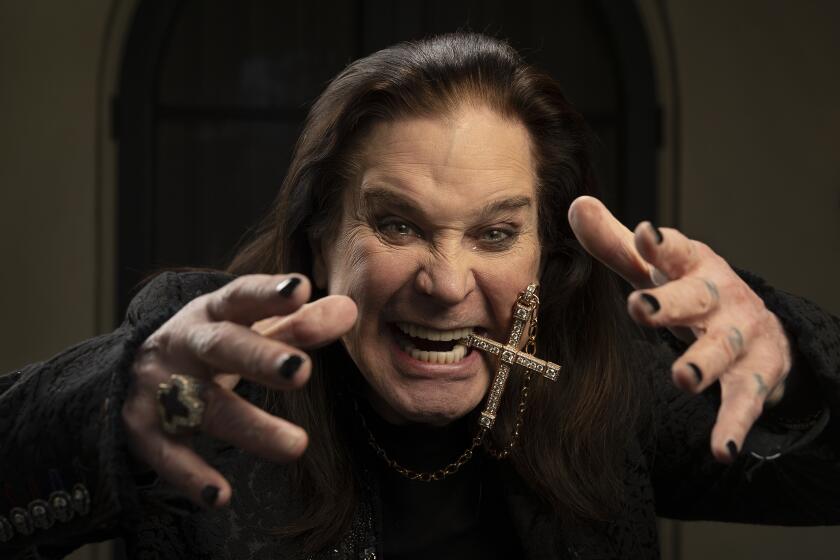The Rock ‘n’ Roll Doc Practices Medicine and Music
- Share via
Patients don’t fret if they have to wait for their appointment with Dr. Stephen Patt.
But they can if they want to.
All they have to do is walk from the doctor’s medical waiting room into his musical practice room.
That’s where they can finger the strings of a used Fender Stratocaster or Gibson Goldtop Melody Maker or strum an ancient Rickenbacker, Gretsch flattop or 150 other vintage guitars.
One moment Patt is a medical doctor tending to the aches of patients. The next he is the Guitar Doc, ministering to the angst of serious rock ‘n’ roll musicians.
The front part of his medical office on National Boulevard on the Westside is a retail showroom filled with old guitars, amplifiers, picks and strings. In the corner is a soundproof practice room where musicians’ amplified riffs and rumbles won’t bother anyone.
The back half contains Patt’s reception area and waiting room, examination room and office.
Rock ‘n’ roll sets the tone there, too.
On one side of Patt’s desk are framed medical certificates and diplomas from places like the University of Maryland’s School of Medicine. On the other are glossy, autographed photos of famed guitarists.
A giant poster signed by legendary electric guitar innovator Les Paul is displayed in the doorway leading from the medical side to the musical side.
“We try to keep our priorities straight,” said Patt, 46. “My medical practice is the most important part of this. But it’s hard to abandon a whole part of your life.”
Indeed. Before becoming a medical doctor, Patt was a guitarist in the 1960s and ‘70s for such rock ‘n’ roll stars as Edgar Winter and the Chambers Brothers.
*
His first stage gig was as a 12-year-old in Baltimore. As a teenager he played folk music and country-rock with a succession of bands, including Northwind. At 17 he was a staff member at the Woodstock festival (“I got to hand out rubber checks to the stars,” he says). He joined the Edgar Winter band in 1968.
After touring and recording with the Chambers Brothers in the 1970s, Patt reluctantly realized that music wasn’t going to provide the income needed to raise a family.
Following the lead of his father, a surgeon, and an uncle who was Vice President Hubert H. Humphrey’s personal physician, Patt enrolled in medical school in 1976. He helped put himself through school playing rock ‘n’ roll gigs.
For the 16 years he has practiced medicine, Patt has continued to be just as comfortable with a wah-wah pedal at his foot and a pick in his hand as with a stethoscope around his neck.
He writes a monthly product review column for Vintage Guitar magazine and frequently plays in pickup bands.
This month, he played rhythm guitar before a sold-out crowd at Billboard Live on the Sunset Strip with veteran rockers Lee Sklar (bassist with Jackson Browne and James Taylor) drummer Mike Baird (Ry Cooder band) and guitarist Jon Butcher.
About a third of his patients, like Butcher, are in the music business, according to Patt. Some, like guitarist Bruce Michael Paine of Venice, are also customers.
“I buy strings, picks and pedals from him,” Paine said. “When I go for a doctor’s appointment, I’ll go in his guitar shop and sit and noodle while I’m waiting.”
*
Paine, a veteran band member and stage performer, said he switched to Patt after tiring of physicians “who don’t quite understand some of the ailments common to this industry--nerves jangled over being up all night and whatever, certain things you do with your hands and fingers that cause carpel tunnel syndrome, hearing loss.”
Patients such as Imbi Rebane who are not musicians never realize there is a guitar shop in front. The Los Angeles student didn’t hear a sound the other day as she stopped in for a checkup.
But a few feet away in the soundproof room, Eric Weinthal was trying out a 1942 Gibson L-5 arch-top. Although the guitar store is normally open only on Saturdays or by appointment, the Toronto filmmaker had stopped in when he noticed that the storefront door was open.
Patt came out to show him some other guitars. “Did you see the white Penguin over there? Isn’t it beautiful?”
From the back, medical receptionist Deia Craine buzzed. A patient’s test results were ready.
As Weinthal strummed in the background, Patt talked with the lab and then called a Santa Monica hospital to alert the staff that the patient would be arriving within the hour.
Hanging up, Patt continued his conversation without missing a beat. “Isn’t that cool? Eric Clapton would like it. It’s pretty playable for a 1950s guitar. A year ago it was turned into a Penguin.”
*
The phone rang again. A patient was on the line this time. “The lab tests show you have a little problem with your blood,” Patt said. “You’re a little anemic. Your kidneys are fine, your liver’s great. Your cholesterol is wonderful.”
When the call was over, he turned once more to Weinthal, who was fingering a different guitar.
“Doesn’t that one resonate great? It’s from the early ‘30s. It’s a predecessor to the electric guitar,” Patt explained. “It’s got a metal resonator inside to amplify the sound.”
Along with the vintage guitars in the store, Patt has a $325 glider chair on display that is designed to improve the circulation of bluegrass players who sit for hours at a time with their instruments.
He also has a vintage Honda motorcycle sitting in the front window. It’s something designed to improve Patt’s peace of mind.
“My wife and I and our two kids live in Topanga Canyon. The motorcycle is my way to get through traffic and get home in case of a fire up there,” he said.
Old rock ‘n’ roll guitarists are a plucky bunch.
More to Read
The biggest entertainment stories
Get our big stories about Hollywood, film, television, music, arts, culture and more right in your inbox as soon as they publish.
You may occasionally receive promotional content from the Los Angeles Times.











